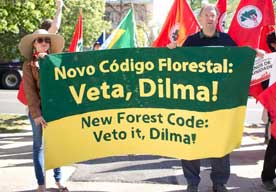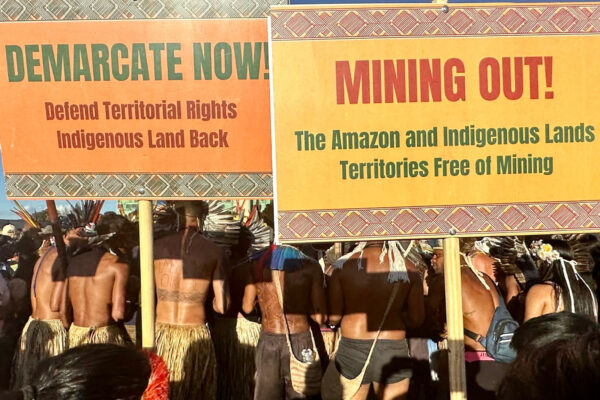The Embassy of Brazil in Washington, DC – a modernist building that contrasts with the classical buildings of the beautiful Embassy Row, embassy sector of the United States capital – was the scene of a march yesterday that brought together about 100 people. In attendance were students, activists, and Brazilians who live in the region that expressed their concerns during President Rousseff’s visit to the city. The participants protested against four central themes: violence in the countryside, especially in the Amazon, and impunity of the leaders and executors of these crimes; land reform; changes in the Brazilian Forestry Code; construction of large dams in the Amazon. Posters displayed images of José Cláudio Ribeiro da Silva, his wife Maria do Espirito Santo da Silva, both killed in May 24, 2011, Dorothy Stang, Chico Mendes, and a scene of the burial of 19 landless workers killed in the massacre of Eldorado dos Carajás, in 1996.
“The Amazon and its people want to live. Stop the violence!” said one of the banners, referring to a dramatic situation in the Amazon: the politically motivated assassinations in the region. Photos of Laisa Santos Sampaio, sister of Maria, and Nilcilene Miguel de Lima were paired with their recent statement: “I want to live.” The same words were spoken by Chico Mendes, shortly before his death. Nilcilene is under protection of the National Force, ending soon. Laisa, who also receives death threats, continues without any official protection.
Marguerite Hohm, sister of the missionary Dorothy Stang who was assassinated in Pará in 2005, participated in solidarity with activists who receive death threats in the region. “Enough with the violence in the Amazon,” she said. After serving only part of their sentences, some of those involved in the assassination of Dorothy Stang, such as Bida, one of the leaders, and Fogoió, one of the executors, are already free.
The slogans of the mobilization included social and environmental phrases, against the damming of Belo Monte Dam (“Stop Belo Monte”), against the Forest Code being voted on by the Brazilian Congress (“Veto it, Dilma!”), as well as “Don’t be afraid to say NO to the Agrarian Elite”, and in defense of traditional forest peoples: “Indians, gatherers and farmers: doctors of ecology. ”
Miguel Carter, a professor at American University, said that the present moment called for a reflection. “We don’t know how much longer we’ll be able to keep this planet alive the way that we have inherited it. And there is real wisdom in the backlands of Brazil, in the hinterlands of the Amazon. The Indians, the gatherers, the peasants, are people who often know a lot more about ecology than a lot of the wisecracks that are running our planet today and our governments and international institutions.”
According to him, the traditional people “are real doctors of ecology”. “We should have more humility to recognize their wisdom and respect their power and nurture it, because we have much to learn from the meek of the earth.” Zé Claudio and Maria, honored in February by the UN as “Heroes of the Forest”, were highlighted by Carter as “heroes for the movement of human and environmental rights.”
“This is a march of solidarity with the Brazilian social movements, human rights advocates, environmental activists, indigenous peoples, and peasant movements. And also in protest against the government’s environmental policy,” said Andrew Miller, of Amazon Watch, on the megaphone. “In anticipation of Rio + 20, Roussef parades Brazil as a progressive country with respect to the environment. But the situation on the ground shows a different reality, with the construction of large dams in the Amazon, like Belo Monte; the Forest Code, if Dilma ratifies the law; and especially with the serious situation of violence in the region,” said Miller. “Rio-20: where are human rights in ‘Green Capitalism?'” said another banner.
The organizations present remarked that “deforestation tripled in the first quarter of this year.” “Along with the forest, the people of the Amazon are being killed,” Laisa stated in her speech at the UN as she accepted the award in honor of her sister and her brother-in-law.
Violence is one of the most frightening factors in the Amazon. The death of the environmentalist couple in Pará less than a year ago was followed by the death of Adelino Ramos, Dinho, in Rondônia, in the same week. On March 30, less than two weeks before the march in DC, in the same region where Dinho denounced the illegal logging, Dinhana Nink was killed for the same reason: having reported illegal loggers. Nilcilene Lima, leader of a gatherer community, fears the same fate. “We stand in solidarity, so that those who are far away know that we are united with them. The Brazilian government cannot remain silent,” says Carter.
The march took place on a beautiful spring day in the U.S. capital, with the path colored by flowers, especially the famous cherry blossoms that bloom this time of year. The posters, designed by artist César Maxit, composed a poetic scene that was, at the same time, disturbing. Less than a year after being murdered, Zé Cláudio and Maria had their faces next to the emblematic figures of the destruction of the Amazon, Chico Mendes and Dorothy Stang. They became just what they had feared in life: martyrs of the Amazon. “The same thing they did with Chico Mendes, the same thing they did with sister Dorothy, they want to do with me,” Zé Cláudio had declared, at the TEDXAmazonia event just months before his death.
The posters with the cries of Laisa and Nilcilene, “I want to live,” represent hundreds of people who’s names appears on deaths list, discussed by social movements with the government, and who need urgent protection. The government’s failure to provide these activists with security for their survival in an environment dominated by violence and terror, makes one fear the worst.














